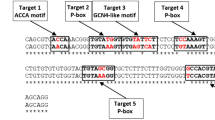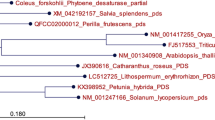Abstract
Transformation of tobacco with the potato gene encoding the subunit of pyrophosphate: fructose-6-phosphate 1-phosphotransferase (PFP) in the antisense orientation under the control of the constitutive CaMV 35S promoter, followed by selfing and crossing of the transformants, generated a line of tobacco (5–37) with up to an 85% reduction in PFP activity in the shoot. Transformants containing a sense construct (4-40-91) contained only 1–3% of wild-type PFP, presumably due to co-suppression. Rates of photosynthesis and partitioning between sucrose and starch in source leaves were identical in 4-40-91 transformants and the wild type. In the dark in sink leaves of 4-40-91 transformants, levels of hexose phosphates were up to 50% higher, glycerate-3-phosphate 30% lower and fructose-2,6-bisphosphate threefold higher than in the wild type; inorganic pyrophosphate, pyruvate and the ATP/ADP ratio were unaltered. Low -PFP and wild-type plants did not differ significantly in their rate of growth at 25° C and 200 μmol quanta · m−2 · s−1 on full nutrient medium. Growth on limiting phosphate and limiting nitrogen was inhibited identically in the wild type and transformants, and transformants adjusted their shoot/root ratio in an identical manner to the wild type. Differences in fructose-2,6-bisphosphate and glycolytic metabolites between the wild type and transformants were no larger in these suboptimal nutrient conditions, than in optimal conditions. Growth of the wild type and 4-40-91 transformants was inhibited identically at 12° C compared to 25° C. Differences in fructose-2,6-bisphosphate were smaller when the genotypes were compared at 12° C than at 25° C. We conclude that PFP does not play an essential role in photosynthate partitioning in source leaves. During respiratory metabolism in sink leaves it catalyzes a net glycolytic flux, as in potato tubers. However, tobacco seedlings are able to compensate for a large decrease in expression of PFP without loss of growth, or the ability to cope with suboptimal phosphate, nitrogen or temperature.
Similar content being viewed by others
Abbreviations
- F2,6BP:
-
fructose-2,6-bisphosphate
- F6P:
-
fructose-6-phosphate
- G6P:
-
glucose-6-phosphate
- PFK:
-
phosphofructokinase
- PFP:
-
pyrophosphate-dependent fructose-6-phosphate 1-phosphotransferase
- 3-PGA:
-
glycerate-3-phosphate
- PPi:
-
inorganic pyrophosphate
- PEP:
-
phosphoenolpyruvate
References
ap Rees, T. (1988) Hexose phosphate metabolism by non-photosynthetic tissues of higher plants. In: Biochemistry of plants, vol. 14, pp. 1–33, Preiss, J., ed. Academic Press, New York
Bastow-Wilson, J. (1988) A review of evidence on the control of shoot-root ratio in relation to models. Ann. Bot. 61, 433–439
Bevan, M. (1984) Binary Agrobacterium vectors for plant transformation. Nucleic Acids Res. 12, 8711–8721
Black, C.C., Mustardy, L., Sung, S.S., Kormanik, P.P., Xu, D.P., Paz, N. (1987) Regulation and roles for alternative pathways of hexose metabolism in plants. Physiol. Plant. 69, 387–394
Botha, A.M., Botha, F.C. (1993) Induction of pyrophosphate-dependent phosphofructokinase in water melon (Citrullus lanatus) cotyledon coincides with insufficient cytosolic d-fructose- 1,6-bisphosphate 1-phosphohydralase to sustain gluconeogenesis. Plant Physiol. 101, 1385–1390
Carlisle, S.M., Blakeley, S.D., Hemmingsen, S.M., Trevanion, S.J., Hiyoschi, T., Dennis, D.T. (1990) Pyrophosphate dependent phosphofructokinase: conversion of protein sequence between the alpha and beta subunits and with the ATP dependent phosphofructokinase. J. Biol. Chem 265, 18366–18371
Chanson, A., Pilet, P.E. (1987) Characterisation of the pyrophosphate-dependent proton transport in microsomal membranes from maize roots. Physiol Plant. 74, 643–650
Claussen, P.A.M., Budde, M.A., de Ruyter, H.D., van Calker, M.H., van Es, A. (1991) Potential role of pyrophosphate:fructose-6-phosphate phosphotransferase in carbohydrate metabolism of cold-stored tubers of Solarium tuberosum. Plant Physiol. 95, 1243–1249
Dennis, D.T., Greyson, M. (1987) Fructose-6-phosphate metabolism in plants. Physiol. Plant. 69, 395–404
Dixon, W.L., Franks, F., ap Rees, T. (1981) Cold lability of phosphofructokinase from potato tubers. Phytochemistry 20, 969–972
Duff, S.M.G., Moorhead, G.B.G., Lefebvre, D.D., Plaxton, W.C. (1989) Phosphate-starvation-inducible ‘bypasser’ of adenylate and phosphate-dependent glycolytic enzymes in Brassica napus suspension cells. Plant Physiol. 90, 1275–1278
Fahrendorf, T., Holtum, J.A.M., Mukherjee, U., Latzko, E. (1987) Fructose-2,6-bisphosphate, carbohydrate partitioning and crassulacean acid metabolism. Plant Physiol. 84, 182–187
Fichtner, K., Quick, W.P., Schulze, E.D., Mooney, H.A., Rodermel, S.A., Bogorad, L., Stitt, M. (1993) Decreased ribulose- 1,5-bisphosphate carboxylase oxygenase in transgenic tobacco transformed with antisence rbcS. V. Relationship between photosynthetic rate, biomass allocation and vegetative plant growth at three different nitrogen supplies. Planta 190, 1–9
Galtier, N., Foyer, C.H., Huber, J., Voelker, T., Huber, S.C. (1993) Effects of elevated sucrose phosphate synthase activity on photosynthesis, assimilate partitioning and growth in tomato (Lycopersicon esculentum UC 82B). Plant Physiol. 101, 535–543
Hajirezaei, M., Sonnewald, U., Viola, R., Carlisle, S., Dennis, D.T., Stitt, M. (1994) Transgenic potato plants with strongly decreased expression of pyrophosphate:fructose-6-phosphate phosphotransferase show no visible phenotype and only minor changes in metabolic fluxes in their tubers. Planta 192, 16–30
Hammond, J.B.W., Burrell, M.M., Kruger N.J. (1990) Effect of low temperature on the activity of phosphofructokinase from potato tubers. Planta 180, 613–616
Hatzfeld, W.D., Dancer, J.E., Stitt, M. (1989) Direct evidence that pyrophosphate:fructose-6-phosphate phosphotransferase can act as a glucolytic enzyme in plants. FEBS Lett. 254, 215–218
Hofgen, R., Willmitzer, L. (1988) Storage of competent cells for Agrobacterium transformation. Nucleic Acids Res. 16, 9877
Jelitto, T., Sonnewald, U., Willmitzer, L., Hajirezaei, M., Stitt, M. (1992) Inorganic pyrophosphate content and metabolites in potato and tobacco plants expressing E. coli pyrophosphatase in their cytosol. Planta 188, 238–244
Jorgensen, R. (1990) Altered gene expression in plants due to trans interactions between homologous genes. Trends Biotechnol. 8, 340–344
Kruger, N.J. (1990) Carbohydrate synthesis and degradation. In: Plant physiology, biochemistry and molecular biology, pp. 59–76, Dennis, D.T., Turpin, D.H., eds. Longman, Harlow, UK
Maniatis, T., Fritsch, E.F., Sambrock, J. (1982) Molecular cloning: a laboratory manual. Cold Spring Harbor Laboratory, Cold Spring Harbor Laboratory Press, New York
Mertens, E. (1991) Pyrophosphate-dependent phosphofructokinase. An anaerobic glycolytic enzyme? FEBS Lett. 285, 1–5
Mertens, E., van Schaftingen, E., Hers, H.G. (1987) Fructose-2,6- bisphosphate and the control of energy charge in higher plants. FEBS Lett. 221, 124–128
Neuhaus, H.E., Stitt, M. (1991) Inhibition of photosynthetic sucrose synthesis by imidodiphosphate, an analogue of inorganic pyrophosphate. Plant Sci. 76, 49–55
Paul, M.J., Stitt, M. (1993) Effects of nitrogen and phosphorus deficiencies on levels of carbohydrates, respiratory enzymes and metabolites in seedlings of tobacco and their response to exogenous sucrose. Plant Cell Environ. 16, 1047–1057
Quick, W.P., Neuhaus, H.E., Stitt, M. (1989) Increased pyrophosphate is responsible for a restriction of sucrose synthesis after supplying fluoride to spinach leaf discs. Biochim. Biophys. Acta 973, 263–271
Rosahl, S. Schell, J., Willmitzer, L. (1987) Expression of a tuber specific storage protein in transgenic tobacco plants: demonstration of esterase activity. EMBO J. 6, 1155–1159
Rowntree, E.G., Kruger, N.J. (1992) Inhibition of pyrophosphate:fructose-6-phosphate 1-phosphotransferase by imidodiphosphate. Plant Sci. 86, 183–189
Schulze, W., Stitt, M., Schulze, E.P., Neuhaus, H.E., Fichtner, K. (1991) A quantification of the significance of assimilatory starch for growth of Arabidipsis thaliana L. Heynh. Plant Physiol. 95, 890–895
Stitt, M. (1990) Fructose-2,6-bisphosphate as a regulatory molecule in plants. Annu. Rev. Plant Physiol. Plant Mol. Biol. 41, 153–158
Stitt, M., Huber, S.C., Kerr, P. (1987) Control of photosynthetic sucrose synthesis. In: The biochemistry of plants, vol. 8, Photosynthesis, pp. 328–410, Hatch, M.D., Boardman, N.K., eds. Academic Press, San Diego
Sung, S.-P.S., Xu, D.-P., Black, C.C. (1989) Identification of actively filling sinks. Plant Physiol. 89, 1117–1121
Theodorou, M.E., Plaxton, W.C. (1993) Metabolic adaptations of plant respiration to nutritional phosphate deprivation. Plant Physiol. 101, 339–344
Theodorou, M.E., Plaxton, W.C. (1994) Induction of PPi-dependent phosphofructokinase by phosphate starvation in seedlings of Brassica nigra. Plant Cell Environ. 17, 287–294
Trevanion, S.J., Kruger, N.J. (1991) Effect of temperature on the kinetic properties of pyrophosphate:fructose-6-phosphate phosphotransferase. J. Plant Physiol. 137, 753–759
van Schaftingen, E., Hers, H.G. (1983) Fructose-2,6-bisphosphate in relation with the resumption of metabolic activity in slices of Jerusalem artichoke tubers. FEBS Lett. 164, 195–200
van Schaftingen, E., Lederer, B., Bartrons, B., Hers, H.G. (1982) A kinetic study of pyrophosphate:fructose-6-phosphate phosphotransferase from potato tubers. Eur. J. Biochem. 129, 191–195
von Schaewen, A., Stitt, M., Schmidt, R., Sonnewald, U., Willmitzer, L. (1990) Expression of a yeast-derived invertase in the cell wall of tobacco and Arabidopsis plants leads to accumulation of carbohydrate and inhibition of photosynthesis and strongly influences growth and phenotype of transgenic tobacco plants. EMBO J. 9, 3033–3044
Author information
Authors and Affiliations
Additional information
This work was supported by the Bundesministerium für Forschung and Technologie (M.S, U.S.) and the Canadian Research Council (S.C., D.D). M.P. was supported by a Royal Society Fellowship.
Rights and permissions
About this article
Cite this article
Paul, M., Sonnewald, U., Hajirezaei, M. et al. Transgenic tobacco plants with strongly decreased expression of pyrophosphate: Fructose-6-phosphate 1-phosphotransferase do not differ significantly from wild type in photosynthate partitioning, plant growth or their ability to cope with limiting phosphate, limiting nitrogen and suboptimal temperatures. Planta 196, 277–283 (1995). https://doi.org/10.1007/BF00201385
Received:
Accepted:
Issue Date:
DOI: https://doi.org/10.1007/BF00201385




